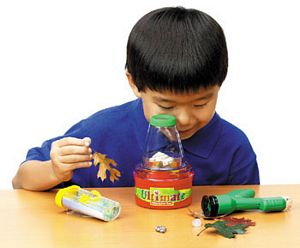
Jesus Teran traps an insect on a bush at The Dalles Imagination Garden (“The DIG”) in the Port of The Dalles. He was taking part in a second through fifth grade Chenowith Elementary after school program. The Junior Master Gardener program was organized by the Wasco County Master Gardeners and 4-H Development Program, and involved multiple visits to the garden, where they learned to plant with seeds, bulbs and transplants, tasted flowers and vegetables and, Thursday May 16, enjoyed a nature walk, made bug traps and learned about garden insects. Photo by Mark Gibson.
The Dalles — The first step in solving a problem is awareness that there is a problem. In the case of declining pollinator species the awareness phase is not only upon us but has moved into the definitely a problem phase. Unfortunately, there are many factors contributing to this situation. Factors such as: pesticides and herbicides, habitat loss and fragmentation, reduction in food sources, nesting and mating sites, predators, parasites, pathogens, and lack of floral and bio diversity. Due to their small size, inconspicuous nature and relative past abundance, it has been far too easy to take pollinators for granted. We have only just begun to appreciate what these little critters do for us. Pollinators are required for the reproduction of around 90 percent of flowering plants, 75 percent of crop plants, and contribute to over one third of foodstuff in the human diet. Urban growth expansion and construction, along with miles of lawns and ag practices that remove hedge rows and buffer strips, figure greatly in habitat loss. Most pollinator species don’t live long and thus don’t travel far. When ideal habitat for food, mating, nesting, egg laying and rearing young is found they will tend to stay awhile. However, overtime, isolated fragments of habitat lose biodiversity in both plant and pollinator species. The Conservation Reserve Enhancement Program (CREP), the farm program that funds riparian buffers along waterways, has been a valuable tool in the conservation toolkit. Not only does riparian foliage help to decrease water evaporation along waterways, it also helps to create habitat highly beneficial to fish, plant, insect, and animal populations. Organic decay benefits the soil and increases plant growth while plant roots hold soil in place and cycles nutrients. The continuous buffer corridor provides space for a plethora of insect and animal species to safely hunt, nest, and rear young. It also provides for a wider disbursement of plant, animal, and insect species across the landscape. This program is a perfect opportunity to increase pollinator friendly plantings. When considering a planting, whether it’s a buffer strip along crop and field, creek or stream, roadside or parkway; consider the addition of plants frequented by pollinators. There are many plants to choose from that can provide continuous food from spring through fall to help sustain pollinator species as they move about the landscape.
Some simple things that can have positive impacts on pollinator species:
-Before planting consider the type of plants that benefit pollinators;
-sow unused fields with native flowers;
-create hedgerows and windbreaks with a variety of plants with overlapping flowering periods;
-leave natural undeveloped areas;
-avoid fancy hybrid flowers that do not produce nectar or pollen;
-minimize pesticides — seek out safer alternatives; and
-add flowering plants, such as legumes, to cover crops for a temporary bee pasture.
When considering pollinator nesting needs, untouched dirt piles and bare areas next to a pond or field for ground nesting bees and standing dead trees are great for a plethora of native pollinators.
For more information check out: http://pollinator.org, http://www.esa.org, and the resource link atwww.wascoswcd.org
Article via: http://www.thedalleschronicle.com/news/2013/may/17/nurture-beneficial-insects-pollinator-friendly-lan/

 The new children's book
The new children's book  The new children's book
The new children's book  There are educational toys of all types in our
There are educational toys of all types in our  There are educational toys of all types in our
There are educational toys of all types in our